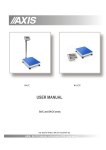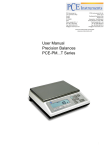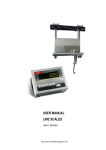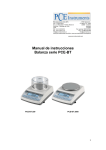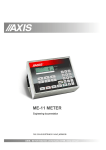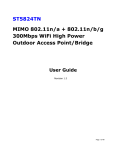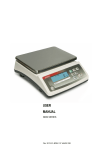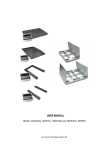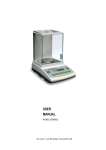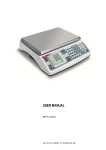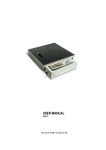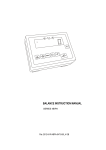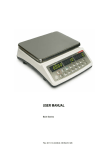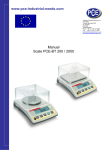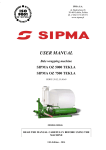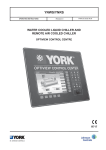Download USER MANUAL
Transcript
4BA/P USER MANUAL 4BA/P File: 2015-03-18 4BAP bE0101 GB AXIS, 80-125 Gdańsk, ul.Kartuska 375B, www.axis.pl 2 USER MANUAL _____________________________________________________________________________________________________________________ Contents: 1. General description ______________________________________________________________ 3 2. Certificates ____________________________________________________________________ 5 3. Set __________________________________________________________________________ 5 4. Technical data__________________________________________________________________ 5 5. Security rules __________________________________________________________________ 6 6. Scale external outputs ___________________________________________________________ 7 6.1 Connecting a computer, printer or label printer _________________________________________ 9 6.2 Detailed LonG protocol description _________________________________________________ 10 6.3 Detailed EPL protocol description __________________________________________________ 12 7. Balance preparation to work ______________________________________________________ 13 8. Operation principles ____________________________________________________________ 14 9. Balance test and adjustment ______________________________________________________ 14 10. Accumulator change (ME-01 option)________________________________________________ 15 11. Scale with ME-01 meter keys and indicators _________________________________________ 16 12. Start-up ______________________________________________________________________ 18 13. Weighing with tare _____________________________________________________________ 19 14. Scale menu ___________________________________________________________________ 20 15. Menu navigation rules ___________________________________________________________ 21 16. Scale setup (SEtUP) ____________________________________________________________ 26 16.1 Scale calibration (CALIb) ________________________________________________________ 28 16.2 Autozeroing function (AutoZEr) ___________________________________________________ 29 16.3 Weight unit selection (UnIt) _______________________________________________________ 30 16.4 Serial port parameters setting (SErIAL) _____________________________________________ 31 16.5 Printout configuration (PrInt) _____________________________________________________ 32 16.6 Setting backlight function (b_LIGHt) ________________________________________________ 34 16.7 Analog out configuration (AnALoG) ________________________________________________ 35 16.8 Entering reference zero value (ZErO) _______________________________________________ 36 17. Special functions description______________________________________________________ 37 17.1 Products and users database (Prod i USEr) __________________________________________ 38 17.2 Pieces counting function (PCS) ___________________________________________________ 42 17.3 Percentage weighing function (PErC) ______________________________________________ 43 17.4 Label choosing function (LAbEL) __________________________________________________ 44 17.5 Weighing animals function (LOC) __________________________________________________ 45 17.6 Constant tare memory function (tArE) _______________________________________________ 46 17.7 Maximum value indication function (UP) _____________________________________________ 48 17.8 Force measuring function (nEWton) _______________________________________________ 49 17.9 Total weight function (totAL) ______________________________________________________ 50 17.10 Checkweighing function (thr)______________________________________________________ 52 17.11 Setting date and time function (dAtE) _______________________________________________ 55 17.12 Radio communication channel choice function (rF CHn) ________________________________ 56 17.13 Charging accumulators function (bAttErY)- option _____________________________________ 57 17.14 Automatic switching off the scale function (AutoOFF) ___________________________________ 58 17.15 Statistical calculations function (StAt) _______________________________________________ 59 17.16 Paperweight calculation (PAP) ____________________________________________________ 62 18. Maintenance and small repairs ____________________________________________________ 63 Declaration of Conformity _____________________________________________________________ 64 Appendix A ________________________________________________________________________ 65 USER MANUAL 3 _____________________________________________________________________________________________________________________ 1. General description 4BA150P scales are designed for precise determination of animal weight. It allows for proper medicines dosing according to the “patient’s” weight. All balances are tested in respect of metrology. According to order, balances may be verified or calibrated. Verified balances have the following verification features: - protection stamps, located on balance meter and converters connection box (installed under the bearing surface). - Office of Measures marks and green metrological mark, located on the rating plate. EC verification is valid for 25 months from 1st of December of year, when the EC verification took place, under condition of stamp integrity. Balances classification (PKWiU code) 29.24.23. Depending on scale’s application it can be equipped with following meter: ME-01/A/18 (LED) - Standard universal ME-01 meter in aluminium (A) housing and LED display (18mm digits height). Full set of special functions (chapter 15) and standard set of keys. ME-01/A/LCD - Standard universal ME-01 meter in aluminium (A) housing and LCD display (18mm digits height). Full set of special functions (chapter 15) and standard set of keys. ME-01/N18 (LED) – Standard universal ME-01 meter in stainless steel housing and LED display (18mm digits height). Full set of special functions (chapter 15) and standard set of keys. 4 USER MANUAL _____________________________________________________________________________________________________________________ ME-01/N/LCD - Standard universal ME-01 meter in stainless steel housing and LCD display (18mm digits height). Full set of special functions (chapter 15) and standard set of keys. ME-01/N/25 – Universal meter with LED display (25mm digits height) in stainless steel housing. Full set of special functions (chapter 15) and standard set of keys. ME-11/N/LCD (surcharge) – meter with numerical keyboard designed to operate special functions that need inscribing data (e.g. product code, unitary mass), stainless steel housing. SE-03/N/LCD (surcharge) – designed to cooperate with label printer, numerical keys, stainless steel housing. USER MANUAL 5 _____________________________________________________________________________________________________________________ 2. Certificates Certificates: Certificate of type approval no. T7950 AXIS management System Certificate DIN EN ISO 9001:2000 No. 78 100 6386 3. Set 1. 2. 3. 4. Basic set includes: The scale RS232C joint User manual Guarantee 4. Technical data Scale type Maximal load (Max) Readout unit (d) Verification unit (e) Minima load (Min) Accuracy class Working temperature Tare range Weighing time Platform dimensions Platform height Display-platform cable lenght Supply Internal supply (option) Accumulator working time Scale weight 4BA150P 150kg 50g 50g 1kg III 0÷40°C -150kg ok. 5s 920x500mm 50mm 2m ~230V, 50Hz, 6VA NIMH (AA size) – 4 pcs About 6h with backlighting About 16h without backlighting 21kg USER MANUAL 6 _____________________________________________________________________________________________________________________ 5. Security rules To avoid electrical shock or damage of the scale or connected peripheral devices, it is necessary to follow the security rules below. To supply scale use socket with safety contact (scales with feeder exluded). All repairs and necessary regulations can be made by authorised personnel only. To avoid fire risk use a feeder of an appropriate type (supplied with the scale). Pay attention that supply voltage is compatible with specified technical data. Do not use the scale when its cover is opened. Do not use the scale in explosive conditions. Do not use the scale in high humidity. If the scale seems not to operate properly, unplug it from the mains and do not use until checked by authorised service. According to legal regulations it if forbidden to dispose wasted electronic equipment in waste containers. Please return wasted scale to the point of purchase or other company specialised in recycling of wasted electronic components. USER MANUAL 7 _____________________________________________________________________________________________________________________ 6. Scale external outputs ME-01 meter in aluminium housing: RS232C RxD (receive) TxD (transmission) 1 2 3 4 5 mass 6 7 8 RS232C WY Feeder Extensometer 9 housing 12V 1,2A WY (option) P1 (threshold I) P2 (threshold 2) P3 (threshold ) 1 2 3 4 5 housing ground 6 7 8 9 USER MANUAL 8 _____________________________________________________________________________________________________________________ ME-01 meter in stainless steel housing: RS232C 2 RxD (receive) 1 3 9 4 housing 5 Feeder ground 7 8 6 USB RS232C Extensometer Power unit 12V Ground Separate ground connection (scales in stainless steel version) must be connected using additional conductor. Extensometers are connected permanently. USER MANUAL 9 _____________________________________________________________________________________________________________________ 6.1 Connecting a computer, printer or label printer The scale is equipped with RS232C, which can be used to connect external devices such as computer or a printer. When cooperating with computer, the scale sends weighing result after initialize signal from computer or after pressing key on the scale. When cooperating with a printer data is send automatically after result stabilisation, but next transmission is possible after removing previously weighted sample. When cooperating with label printer after pressing key, the scale sends instructions set for the label printer. Label number 0001, hour, data (if the clock is installed and on) and nett weight. During transmission LabEL communicate is displayed. The way of sending data and transmission parameters is set using SErIAL special function. Set of send data is set using special function PrInt. The following data can be send: - Header (scale type, Max, d, e, serial number), - Operator identification number, - Successive printout number (measurement), - Identification number or product bar code, - Number of pcs (PCS function only), - Single detail mass (PCS function only), - Nett weight, - Tare (package mass), - Gross weight, - Total mass (Total function only). If the scale is equipped with two serial joints Print function is set independently for both interfaces. Computer must have a special program for cooperation with data from a scale. Dedicated programs are also offered by AXIS. Except RS232C joint, the scale can be equipped with USB or Wi-Fi interface. Needed controllers and instruction can be found on a CD supplied with Axis scales. USER MANUAL 10 _____________________________________________________________________________________________________________________ 6.2 Detailed LonG protocol description Communication parameters: 8 bits, 1 stop bit, no parity, baud rate 4800bps, initialising signal (data send order) – correspond to press key ComputerScale: S I CR LF (53h 49h 0Dh 0Ah), ScaleComputer: scale response according to description below (16 bytes): Byte Byte Byte Byte Byte Byte Byte Byte Byte Byte Byte 1 2 34 5÷9 10 11 12 13 14 15 16 - sign „-” or space space digit or space digit, decimal point or space digit space k, l, c, p or space g, b, t, c or % space CR LF Attention: Network number different than zero (SErIAL / nr function) changes scale working mode: communication with a computer is possible after logging the scale in with 02h scale number command. To log the scale out use 03h command. For example: Using a program to test RS232 interface ( program is available in www.axis.pl / programy komputerowe ) for scale number 1 please write: $0201 to log in, then SI, and write: $03 to close communication. Asking about scale presence in system (testing scale connection with computer): ComputerScale: S J CR LF (53h 4Ah 0Dh 0Ah), ScaleComputer: M J CR LF (4Dh 4Ah 0Dh 0Ah), Displaying a inscription on scale’s display (text communicate from computer): ComputerScale: S N n n X X X X X X CR LF, nn-displaying time in seconds; XXXXXX-6 signs to display ScaleComputer: M N CR LF (4Dh 4Eh 0Dh 0Ah), Scale tarring (calling T key press) : ComputerScale: S T CR LF (53h 54h 0Dh 0Ah), ScaleComputer: without response, Scale zeroing (calling 0 key press): Computer Scale: S Z CR LF (53h 5Ah 0Dh 0Ah), Scale Computer: without response, Scale turning on / off (calling I/ key press): Computer Scale: S S CR LF (53h 53h 0Dh 0Ah), Scale Computer: without response, USER MANUAL 11 _____________________________________________________________________________________________________________________ Entering to special function menu (calling MENU key press): Computer Scale: S F CR LF (53h 46h 0Dh 0Ah), Scale Computer: without response, Setting threshold 1 value (option): Computer Scale: S L D1...DN CR LF (53h 4Ch D1...DN 0Dh 0Ah) D1...DN – threshold value, maximum 8 characters („-” – negative value, digits, dot – decimal separator), number of digits after dot should be the same as on scale display, Scale Computer: without response, Example: in order to set low threshold 1000g in scale B1.5 (d=0.5g) the following order should be sent: S L 1 0 0 0 . 0 CR LF (53h 4Ch 31h 30h 30h 30h 2Eh 30h 0Dh 0Ah), in order to set low threshold 100kg in scale B150 (d=50g) the following order should be sent: S L 1 0 0 . 0 0 CR LF (53h 4Ch 31h 30h 30h 2Eh 30h 30h 0Dh 0Ah),), Setting threshold 2 value (option): Computer Scale: S H D1...DN CR LF (53h 48h D1...DN 0Dh 0Ah), D1...DN – threshold value, maximum 8 characters Scale Computer: without response. Setting threshold 3 value (option): KomputerWaga: S M D1...DN CR LF (53h 4Dh D1...DN 0Dh 0Ah), gdzie: D1...DN – threshold value, maximum 8 characters WagaKomputer: without response. Connecting cable WK-1 (scale – computer / 9-pin interface): SCALE COMPUTER Connection cable WD-1 (connects scale with AXIS printer): SCALE KAFKA PRINTER Setting of internal switches of AXIS printer: SW-1 on SW-2 off SW-3 on SW-4 off SW-5 off SW-6 on SW-7 off SW-8 off USER MANUAL 12 _____________________________________________________________________________________________________________________ 6.3 Detailed EPL protocol description Transmission parameters: 8 bits, 1 stop bit, no parity, baud rate 9600bps, After using key in scale: ScaleLabel printer : set of instruction in EPL-2 language that initialize label printing: US FR"0001" ? mm:gg rrrr.mm.dd masa P1 - Steering instruction Label number define instruction Instruction that starts list of variable signs 5 signs: minutes:hour 10 signs: year.month.day 10 signs: scale indication+ mass unit Steering instruction Attention: a. Except variable signs constant signs can also be inscribed e.g. factory name, product name and so on. b. In standard only one label pattern is possible to printout (number 0001). Using bigger amount of patterns (other label numbers) is possible thanks to LAbEL special function. c. To achieve label printout, label printer must have inscribed label pattern (label pattern is created on computer and using computer it is saved to label printer memory). Label pattern is designed by ZEBRA DESIGNER program which is supplied together with label printer. Scales parameters and transmission protocol must corespond to label printer type. USER MANUAL 13 _____________________________________________________________________________________________________________________ 7. Balance preparation to work 2. Unpack the balance, remove protective foils. 3. Remove the pan and transport protective elements from below the scale. 4. Place balance on flat, horizontal foundation, in place not subjected to mechanical vibrations and strong air movements. 5. Using rotary legs set the scale level. Air bubble in level should be located in the middle position. 6. Put on the pan. Correct 8. Wrong 7. Attach meter to the wall, desktop or tripod (option), choosing one of three methods. USER MANUAL 14 _____________________________________________________________________________________________________________________ 8. Operation principles 1. Before each measurement the balance should be properly zeroed, which is signalled by “” indicator. If the zero indication is not shown when the balance is unloaded, or "----" is displayed, press the "" key. 2. The balance enables tare setting in the whole measuring range. It is performed by pressing "T" key. 3. Weighed mass should be placed in the platform centre. Do not drop weighed objects on the platform. Do not overload the balance over 20% of maximum load. 4. The weighing result should be read during the " " indicator lighting, which indicates the result stabilization. 5. When there is no weighing, but the balance should be ready for operation, it may be switched off by I/ key. It causes the balance reading system deactivation end entering the standby mode. Balance turning on is performed by pressing " I/ " key. 6. Protect the balance from dust, aggressive dusts and liquids. For cleaning purposes use water and dry it 9. Balance test and adjustment During balance operation, in order to confirm its efficiency, it is recommended to check the weighing precision by putting and object of exactly known weight before and after series of measurements. For testing of verified balances use weight standard, having valid standardization certificates. In case of allowable measurement error exceeding contact authorized service company to perform balance adjustment. Balance adjustment must be performed by authorized service company only, as it is connected with necessity of seals breaching, required for warranty purposes. USER MANUAL 15 _____________________________________________________________________________________________________________________ 10. Accumulator change (ME-01 option) 11 12 13 RS232C WY 1. Remove screws 11 holding plate 12, remove the plate. 2. Take out container with accumulators 13 and place 4 AA format accumulators. The way of packing accumulators into the container is shown on the figure on the left and is also shown on the container. Tensometr Extensometer 12V 1,2A USER MANUAL 16 _____________________________________________________________________________________________________________________ 11. Scale with ME-01 meter keys and indicators LCD display version: zero stabilization net weight weighing result indicator indicator indicator Max= metrological data d= bar indicator 0 kg scale keys Keys: " " " " " " Indicators: " " " " " " " " " " " " " " bar I/ T 0 MENU HR 0 NET MODE B/G AUT T TOTAL, FILTER, SUM %, ct, n, g/m2, lb,mg pcs n OFF MIN OK MAX BAT , O indicator - switch-on / switch-off (standby), tare, menu position confirmation, next digit (when inscribing), zeroing, scrolling menu, increasing digit (when inscribing), result printout, decimal point (when inscribing), menu, function switch: special function/weighing, temporary high resolution indication, zero indicator (unloaded scale), result stabilization indicator, - net weight (after using T key), special function menu turning on indicator gross weight (after using TARE and key) autotare function on, tare memory function on, special functions indicators, unit indicators, pieces counting indicator, measurements quantity indicator (total function), scale turned off (standby) weighing result under threshold I (thr function), weighing result between threshold I and II, weighing result above threshold II, battery discharge indicator, ACtIV function indicator, scale load indicator (0-100%) USER MANUAL 17 _____________________________________________________________________________________________________________________ LED display version: zero stabilization net weight indicator indicator indicator weight result Max= metrological data d= scale keys klawisz " " " " " " wskaźnik " " " " " " " " " " " I/ T 0 MENU HR 0 NET W1 W2 HOLD FUNC PCS g, kg, lb, unit MIN OK MAX - switch-on / switch-off (standby), tare, menu position confirmation, next digit (when inscribing), zeroing, scrolling menu, increasing digit (when inscribing), result printout, decimal point (when inscribing), menu, function switch: special function/weighing, temporary high resolution indication, zero indicator (unloaded scale), result stabilization indicator, - net weight (after using T key), first range on in two-range scale, second range on in two-range scale, indication „locked” (concerns LOC and UP functions), special function turned on, pieces counting, weight unit (g-gram, kg-kilogram, lb-pound, unit – other), weighing result under threshold I (thr function), weighing result between threshold I and II, weighing result above threshold II, During inscribing numerical values needed during using special functions keys have special functions. USER MANUAL 18 _____________________________________________________________________________________________________________________ 12. Start-up Leave the pan empty, plug a scale to the mains with a ground contact The scale proceeds with following start-up actions: 0 Display test. kg Meter type displaying Program version 0 kg Attention: Displaying program version means positive result of all tests. The scale is now ready to work. USER MANUAL 19 _____________________________________________________________________________________________________________________ 13. Weighing with tare kg 0 kg If the scale is not loaded and 0 indicator doesn’t indicate, press 0 key. Zero indication and 0 indicator mean that the scale is ready to work. kg After putting container (package) tare the scale using T key. NET indicator will show up. kg kg kg Put on weighted object and readout net weight (NET indicator shows that scale indicates net weight). In order to readout gross weight press key (B/G indicator shows that scale indicates gross weight). Press again key in order to come back to net indications. USER MANUAL 20 _____________________________________________________________________________________________________________________ 14. Scale menu All scales except for basic metrological functions: weighing and taring, have many special functions and configuration options. In order to ease using functions user can create his own (personalized) menu. 0 kg Creating personalized menu: In „out of the box” scale after pressing MENU key only SEtuP option (it contains all configuration options) is available. One of the configuration options is Menu that is used to create personalized menu. To add a function to personalized menu press T key when the function is indicating. Chosen function is indicated with „o” sign on the left side of display. After adding all necessary functions press out in order to come back to weighing mode. User now after pressing MEnu key has access to selected earlier functions and to SEtuP option. dEFAULt option is used to set factory settings. USER MANUAL 21 _____________________________________________________________________________________________________________________ 15. Menu navigation rules Choosing menu options: 0 kg First position of scale menu shows up after pressing Menu key. The position is displayed for about 7 seconds and then the scale sequentially displays next menu positions. Choosing menu position (option) is done by pressing T key when it is displayed on the screen. After choosing position (option) usually several options show up: on – turning on selected option, OFF - turning off, out – out to menu. Accelerated working with menu: Menu first position is displayed for about 7s. During this time user can view next positions by using key (or 0 ). 0 kg Immediate out to previous menu level is done by using Menu key. USER MANUAL 22 _____________________________________________________________________________________________________________________ key working method: 0 kg During standard weighing key is used to switch between net and gross indication. 0 kg 0 kg 0 When special function e.g. PCS is turned on, using key enables to go back to standard weighing mode. 0 kg 0 Sign „o” on the left side signalizes that special function is turned on and user can go back to function mode by pressing key. USER MANUAL 23 _____________________________________________________________________________________________________________________ HR key working method: 0 During normal weighing temporary (5s) readout resolution increase is possible. kg Return to normal indication is made automatically. 0 kg 5s. 0 kg Inscribing numerical values: Inscribing numerical values is needed in some special functions e.g. tArE function requires to inscribe tare values. Keys: 0 - increasing digit value, - decimal point, T - next digit position, MENU - end of inscribing. USER MANUAL 24 _____________________________________________________________________________________________________________________ Menu diagram: MENU key (PCS) (totAL) - personalized function menu created using SEtUP / MEnu ... ... SEtUP out MEnu (o) Prod USEr PCS Unit PErc LOC tArE UP NEWton totAL thr StAt PAPEr out - settings - creating menu (”o“- added to menu) - choosing product - choosing user - pieces counting function - actual unit selection - percentage conversion function - animals weighing function - tare memory bank - maximum value function - force and torque value function - summation series of measurements function - threshold values comparing function - statistics function - paper grammage function - exit CALIB CAL on CAL StP out - sensitivity calibraton (only not verificated scales) - fast calibration (without confirmation of putting weight) - calibration with confirmation - exit - autozeroing AutoZEr Aut on AUt OFF out UnIt CArAt (ct) MGrAM (mg) HGrAm (kg) Pound (Ib) ounCE (oz) ounCE (ozt) GrAin PEnnYW GrAM (g) out - autozeroing on - autozeroing off (lasts 10min) - exit - unit choice - carat - miligram - kilogram - pound - ounce - aphotecary ounce - grain - jednostka jubilerska - gram - exit USER MANUAL 25 _____________________________________________________________________________________________________________________ SErIAL Port-1 Port-2 out PrInt Port-1 Port-2 out - serial ports settings settings - port - 1 bAUd - transmission speed (1200, ... ,115 200 bps) bItS - bits quantity (7 or 8) PArItY - parity control SEndInG - transmission type (Stab, no StAb, Auto,Cont.,rEMoVE) Prot - protocol (LonG, EPL, EPL_A, EPL-d, PEn-01) SCAnn - cooperation with barcode readers MJ-4209 out - port-2 (as above) - printout data configuration / transmission - port - 1 - header (scale type, Max, d, e, serial nr) HEAdEr - scale operator id number User Id - user name User nA - succesive printout/measurement number Prn no - product identification number Prod Id - product barcode number Prod bA - product name Prod nA - pieces quantity (PCS function) Cont - product unit weight APW - net weight nEtto - package weight (tare) tArE - gross weight Gross - total weight (totAL function) totAL - measurement number and value in one line printout nr LCD - exit out - port-2 (as above) - exit (dAtE) - ustawianie daty godziny (if the scale is equipped with clock) (b_LIGHt) - setting backlight (if display is backlighted) - backlight off - backlight on - turn off after 30 s without activity - as above but only when supplied from accumulators - exit - analog out setting - range value inscribing - configuration (plus, minus, both) - exit b_L oFF b_L on b_L ECO b_L bAt out AnALoG AnG rnG AnG CFG out USER MANUAL 26 _____________________________________________________________________________________________________________________ (bAttEry) - turn on/off accumulator charging (if the scale is equipped with accumulator) (AUto OFF) - automatic turning off - saving accumulator power (as above) (ZEro) - scale start zero inscribing (factory zero) dEFAULt - restore default settings for all options SErVICE - options only for service out - exit USER MANUAL 27 _____________________________________________________________________________________________________________________ 16. Scale setup (SEtUP) SEtUP contains all options used for setting scale work mode: 0 kg MEnu – creating personalized user menu CALIb – scale sensitivity calibration AutoZEro(ing) – self-maintaining zero indication (unloaded scale) UnIt – weight unit selection SErIAL – setting serial ports Print – transmission (printout) data selection FILtEr – anti-disturbance filter b_LIGHt – backlight setting Ad420 – analogue out configuration FIrMW(are) – updating software (only for service) dEFAULt – reset to factory settings (sample of using in chapter 15) SErVICE – service menu (only for service) . USER MANUAL 28 _____________________________________________________________________________________________________________________ 16.1 Scale calibration (CALIb) Press MENU key. 0 kg Press T key when CALIb function appears. The following options will be displayed: -CAL on – calibration with external recommended standard of mass (see technical data). -CAL StP – calibration with external weight, confirmation of succesive steps - MENU key, out – leave without changes Press T key when CAL StP option appears (calibration in two steps). Press T key when weight value used for calibration is indicating or use othEr option and inscribe proper value ( keys 0 , g , T ) Press MENU and wait for writing zero to the scale. When LOAD message appears put standard of mass on the pan. Press MENU key (CAL on doesn’t need pressing MENU key). Wait until internal calibration is finished and zero indication is displayed. 1000g 0 g USER MANUAL 29 _____________________________________________________________________________________________________________________ 16.2 Autozeroing function (AutoZEr) 0 kg When the function is activated, the scale automatically ensures stable zero indication if the pan is empty or if zero indication was acquired by pressing T key. To turn on the function use MENU key and using T key choose AutoZEr and then Aut on To leave the function press MENU key, then with T key chose AutoZEr and Aut OFF. Note: 1. AUt sign occurs only in scales with LCD display. 2. In scales with 0 key active function changes name into AutoZE (autozeroing) and works only when the scales is unbiased. 0 kg USER MANUAL 30 _____________________________________________________________________________________________________________________ 16.3 Weight unit selection (UnIt) The function allows selecting weighing unit: 0 - CarAt (1 ct= 0,2 g) - carat, kg - MGrAM (1mg=0,001g) milligram, - KGrAM (1kg=1000g) kilogram, - Pound (1 lb=453,592374g) English pound, - OunCE (1oz=28,349523g) - ounce, - OunCEt(1ozt=31,1034763g) pharmaceutical ounce, - GrAIn (1gr=0,06479891g) - grain - PennYW (1dwt=1,55517384g) jewellery mass unit, - GrAM (1g) - gram. The way of choosing carats as weighing unit is shown on the example. Attention: In scale with LED display designations of mass units: lb, kg, oz, ozt, ct are not displayed. Units are pointed by diode light. kg g USER MANUAL 31 _____________________________________________________________________________________________________________________ 16.4 Serial port parameters setting (SErIAL) The function allows setting independently communication parameters of both of serial ports Port-1 and Port-2 (executed in RS232C, RS485, USB or LAN standard): 0 kg - transfer protocol (Prot): LonG – cooperation with printer or computer, EPL – cooperation with label printer in normal mode (activates LAbEL function), EPL_A – cooperation with label printer in automatic mode (activates LAbEL function), EPL_d – cooperation with special label printers, Pen-01 – cooperation with PEN-01, SCAnn – cooperation with MJ-4209 barcode readers. - baud rate (bAud): (4800, 9600, ….115 200bps), - number of bits in single char. (bitS): 7, 8, - parity control (PArItY): nonE – no control Odd –nonparity Even – parity control, - scale number in network (nr): (if the scale doesn’t work in network the number must be 0), - transmission through serial interface (SendInG) : StAb – transmission after stable, key is used and result is noStAb – transmission after key is pressed without need of stabilisation, Auto - automatic transmission after load is put on and result is stable (Auto), Cont - continuous transmission, about 10 results per second (Cont.), Remove - trans Default parameter values: Long, 9600 bps, 8 bits, none, StAb In order to set needed parameters choose SErIAL function, select appropriate parameter and press T key when required option or parameter value is displayed. In scales with an additional serial port appear Port-1 and Port-2, for the independent setting of both ports. USER MANUAL 32 _____________________________________________________________________________________________________________________ 16.5 Printout configuration (PrInt) Function is used for printing additional information stored in scale memory, weighed product identification data and scale operator id. That information is inscribed using scale keys or scanner. 0 kg The function allows to switch on/off following positions on the printout: - HEAdEr – header: name, model and scale number, - USEr Id – scale user identification number, - USEr nA – user name, - Prn no – successive printout number (choose this option to zero counter), - Prod Id – product number, - Prod bA – product barcode (inscribed or scanned), - Prod nA – product name, - Count – counting result (PCS function), - APW – unitary mass (PCS function), - netto – net mass - tArE – current tare value, - GroSS – gross mass, - totAL – total mass (totAL function) Attention: If Prod Id or USEr Id is chosen, it is possible to inscribe quickly their new values (with omission of main menu). In order to do that hold (about 3 seconds) MENU key and release it when Prod Id or USEr Id indicates. Inscribe new value using keys: 0 - increasing digit, - decimal point, T - next digit, MENU - end. While inscribing Prod id user can use barcode reader connected to RS232C interface. If the scale is equipped with two serial joints Print function is set independently for both interfaces. USER MANUAL 33 _____________________________________________________________________________________________________________________ Sample printout during normal weighing (all printout positions deactivated): 20.07 kg 20.04 kg 20.04 kg Sample printout during normal weighing with clock option (all printout positions deactivated): 20.07 kg 2012-11-08 10:01 20.04 kg 2012-11-08 10:01 20.04 kg 2012-11-08 10:01 Sample printout during normal weighing ( some printout positions activated): BA30 MAX: 30kg e=d=0.01kg S/N : ID OPER. DATE TIME NO ID PROD. COUNT APW NET TARE GROSS TOTAL : 000001 : 2012-11-08 : 12:26 : 3 : 01 : 0 PCS : 0.000 g : 3.08 kg : 0.00 kg : 3.08 kg : 0.00 kg USER MANUAL 34 _____________________________________________________________________________________________________________________ 16.6 Setting backlight function (b_LIGHt) The function is used for choosing the work mode of scale display backlight: 0 kg - b_L OFF – switch backlight off, b_L on – switch backlight permanently on, b_L ECO – switch off after 30 seconds of inactivity (no load changes and no key operation), b_L bAt – like above, but when powering from accumulators only, out – out without changes. Switching backlight off causes decrease of energy consumption by the scale, what is important during powering from accumulators. USER MANUAL 35 _____________________________________________________________________________________________________________________ 16.7 Analog out configuration (AnALoG) 0 kg - This option enables to set-up analog out (4-20mA or 010V) working method used e.g. in PLC regulators: AnG rnG – inscribing Max value AnG CFG – working mode configuration (PLUS – workmode for only positive values, MinuS – only for negative values, both – for both) USER MANUAL 36 _____________________________________________________________________________________________________________________ 16.8 Entering reference zero value (ZErO) Note: This function is enabled in non-legalized scales only. ZEr0 function allows entering new value of reference zero (value referred to empty pan) without need of contacting with authorised service centre. 0 kg Press MENU key. When ZErO is displayed press T key. On the display a sign ZEr Cod will show up momentary and the a dash on last digit position. To enter code ( in new scale: 1234) use keys: 0 - increasing digit, T - next digit, MENU – end of inscribing. The following options appear successively on display: ZEr Cod – enter new secure code value, ZEr SEt – enter new zero value Using T key, choose ZEr SEt. Direct result from A/C converter will appear on scale display. When the pan is empty press 0 key. Wait for finishing zeroing process. In order to change access code use ZEr Cod option (as mentioned earlier). USER MANUAL 37 _____________________________________________________________________________________________________________________ 17. Special functions description All scales besides basic metrological functions: weighing and taring, have a set of special functions. Depending on meter type functions set differs. Below a list of functions available in standard ME-01 type meters: Products data base (Prod), Users data base (USEr), pieces counting function (PCS), change of mass unit (UnIt), percentage weighing function (PErC), selecting label number function (LAbEL), weighing large animals function (LOC), entering tare function (tArE), maximum value indication function (UP) force measuring function (nEWton) statistical calculations (StAt) paperweight calculation function (PAPEr) and functions that require additional equipment to be completely functional: option with accumulator supply: - Setting accumulators charging (bAttErY) - Automatic switching off scale function (AutoOFF) options with the clock: - setting current date and time function (dAtE) - total weight function (totAL) options with the transoptors connectors (WY ): - checkweighing function (thr) option with radio connection: - function of choosing communication channel (rF Chn) LabEL function is available in scales with EPL or EPL-A transmission protocol activates (go to SetuP/SErIAL). In scales with LED display special functions don’t have additional marks on display and names of some functions are shortened. USER MANUAL 38 _____________________________________________________________________________________________________________________ 17.1 Products and users database (Prod i USEr) Scale is equipped with products and users database with capacity up to 300 products and 10 users. Database consists of: M nr – memory number where data is saved, Prod Id - product identification number, Prod bA – product barcode, Prod nA – product name, USEr Id – user identification number, USEr nA – user name, APW - unitary weight (used when pieces counting), PtArE - inscribing permament tare to the product, thr Lo - threshold value (low), thr Hi - threshold value (upper). Database can be built in Excel datasheet form, where each product has one row and each column have product data. This way created database, saved in *.csv extension with semicolons can be send to scale using Scale Database software and scale’s serial interface. Scale Database is available on our webpage www.axis.pl/en. Database and possibility to cooperate with external devices: printer, label printer, barcode reader and computer enables to built product identification and product archiving systems. Product barcode readout (during scale working) initiates searching through database and in case of finding proper record, recalls product data (Found communicate). Barcode reader enables also to insert numerical data conveniently (standard ME-01 meter doesn’t have numerical keys). Using alphanumeric code (for example 128 code) it can be also used to insert names of products and users. Producent Produkt: Masa netto: xxxxxxx Data: xx-xx-xxxx USER MANUAL 39 _____________________________________________________________________________________________________________________ Inscribing data to base 0 kg Prod and USEr options enables adding and deleting product and user data. For products database available options are: EdIt – edit product from database, Add – add product to database, dEL OnE – deleting single element from database dEL ALL – deleting all elements from database dAtAb – changing working mode with database (default mode Stb): Stb – searching products in database and working with products outside the base; if product is found then Found communicate appears and all product data is recalled; if there is no product in database then no communicate appears, the scale stores id/barcode number temporarily in memory and enables to send it to the port (to printer/computer) together with actual weighing result. LIMIt – searching through products from database; if product is found then Found communicate appears and all product data is recalled; if there is no product in database then not Found communicate appears. - Prn_P – sending all products database to port. To inscribe data use EdIt option and keys: 0 - increasing digit, T - next dixit, MENU – end of inscribing. Barcode reader (connected to RS232C interface) can also be used to inscribe data and this way it is faster and more effective. Each database product has following data: - M Id – memory cel number in products database, - Prod Id – product identification number, - Prod bA – product barcode, - Prod nA – product name (inscribed from PC or barcode reader), - APW – product unitary weight (optional), - PtArE – product package weight (optional), - thr LO – lower threshold (MIN value), - thr HI – upper threshold (MAX value). Saving inscribed product data is done by using SAVE option. USER MANUAL 40 _____________________________________________________________________________________________________________________ Users database is edited by similar function named USEr and consists of several options: - USEr Id – user identification number, - USEr nA – user name (inscribed from PC or scanner), - Prn_U – sending users database to port. Saving data is also done by SAVE option. Recalling from database - The fastest way to recall product from database is to readout his barcode number (Prod bA) by using barcode reader (option). It can be done in any moment. After readout of proper barcode scale indicates one of communicates: SCAn – barcode from outside the base accepted (Std mode), not Found – barcode from outside the base not accepted (LIMIt mode), Found – product barcode found in database and data recalled. Attention: If the scale doesn’t indicate any communicate, check barcode reader connections, port configuration and transmission protocol (SErIAL function). 0 kg 3 sek. Other fast way is to press and hold MENU key. Prod Id communicate indicates and after a few seconds user can inscribe identification number. If the number is already saved in base Found communicate appears and all the product data is recalled. To edit data choose EdIt option and use following keys: 0 - increasing digit, T - next dixit, MENU – end of inscribing. Product recalling is also possible by using Prod and Prod Id options (previous site). 0 kg USER MANUAL 41 _____________________________________________________________________________________________________________________ Weighing results and data transmission from scale to computer or to printer To each weighing results transmission a set of product and user identification data is added. The set is activated in Print option (17.5 chapter). Available data from products and users base (Print / SEtuP option): - USEr Id – user identification number, - USEr nA – user name (inscribed from PC or scanner). - Prod Id – product identification number, - Prod bA – product barcode (inscribed or scan), - Prod nA – product name (inscribed from PC or scan). USER MANUAL 42 _____________________________________________________________________________________________________________________ 17.2 Pieces counting function (PCS) 0 kg 5 This function enables to count identical pieces, e.g. turnbuckles or buttons. A measurement is performed in two phases: - first phase - single piece weight calculation on the basis of defined pieces amount (5, 10, 20, 50, 100, 200 or 500 pieces), - second phase – pieces counting. First phase options: 0 kg - PCS . . – recalling of a value inserted earlier (this quantity must be inscribed earlier), -PCS SEt – set any amount of pieces in a sample, -PCS APW – set unitary mass directly, -PCS rS – inserting number of details in a sample and receiving of their mass from other scale connected by RS232C. It is advised that single piece weight is not less than one reading unit and sample weight used in first phase is bigger than 100 reading units. To leave function press MENU key and then using T key chose PCS and PCS oFF. Note: 1. APW too LOW communicate signalises that a sample was not put on the pan or if single piece weight is less than one-tenth readout plot (counting is not possible). 2. APW LOW communicate signalizes that single piece weight is more than one-tenth but less than one readout plot. (counting possible but with bigger errors, result blinks). 3. In scales equipped with LED display pcs sign is replaced with “ ■ ”. 0 +10 0 USER MANUAL 43 _____________________________________________________________________________________________________________________ 17.3 Percentage weighing function (PErC) 100% This function allows displaying weighing result in percents. A measurement is performed in two phases: 0 kg - first phase – weighing a reference sample (100%), - second phase – measuring specific sample as a percentage of the reference sample. Weighing result is displayed in different format, depending on the weight value of reference sample. The function has the following options: - PEr oFF – disable the function, - PEr on– set current scale indication as 100% and activate percentage weighing, -out- exit without changing settings. -5% 0 0 Note: 1. PEr Err message informs that reference 100% mass is less than 0,5*Min or was not defined. 2. In scales with LCD display sign "■" is replaced with %. 44 USER MANUAL _____________________________________________________________________________________________________________________ 17.4 Label choosing function (LAbEL) This function is used in scale with EPL (SErIAL function) data protocol. This protocol enables label printout with actual scale indication and chosen data from PrInt special function (variable data), for example date and time. Other data, for example company address, product name, barcode can appear on label as a constant text. Label patterns with number (4 digit) used by user should be saved in scale memory according to printer manual. Label pattern choice is made by inscribing label number using LAbEL function. Press MENU button. When LAbEL is displayed press T key. Actual label number will show. To enter new label number press T key, to exit function without number change press MENU. To inscribe label number use keys: 0 - digit increase, T - next digit, MENU – end. After entering label number, putting load and pressing key will cause sending data to label printer. Data format sent to label printer (label nr 1, language EPL-2): US FR"0001" ? 00:00 2000.00.00 10 g P1 (55 53 0D 0A) (46 52 22 30 30 30 31 22 0D 0A) (3F 0D 0A) (30 30 3A 30 30 0D 0A) (32 30 30 30 2E 30 30 2E 30 30 0D 0A) (20 20 20 20 20 31 30 20 20 67 0D 0A) (50 31 0D 0A) USER MANUAL 45 _____________________________________________________________________________________________________________________ 17.5 Weighing animals function (LOC) The function allows weighing animal moving on the scale. Press MENU key. 0 When LOC function is displayed press T key. The following options appear on display successively: - LOC oFF – leave the function, - LOC on – automatic weighing after loading the scale, - LOC Prn – the measurement initiated manually by pressing kg key. When LOC on is displayed press T key. Tare the scale using T key if necessary and place the animal on the pan. Wait until the weighing result is averaged – scale display blinks. Then scale will show stable (averaged) result and will send it through serial port. The result remains on display for about 30 second. 0 kg 0 kg 0 kg Important notes: 1. The loads lower than Min value are not averaged. 2. In case when putting animal on scale takes more than 5s it is suggested to choose LOC PRN option (measurement started manually by pressing key ). USER MANUAL 46 _____________________________________________________________________________________________________________________ 17.6 Constant tare memory function (tArE) This function enables to measure gross weight of a sample placed in a container of a known weight value (stored in the memory) and to display calculated net weight of the sample. Tare value is recalled from the memory with 0 or T key when the pan is empty. Tare value may be entered using keypad or by putting container on the pan. Inscribing tare value to memory: 0 kg After pressing MENU key and choosing tArE function using T key, the following options are available: tAr 0FF – leave the function, tAr on – activate the function with the previous tare value, tAr .. – sample tare value from the pan, - tAr SEt– enter tare value with keys: 0, - out – printout a setting value of tare. T and MENU , Press T key when tAr SEt is displayed. By pressing T key choose proper memory cell where tare will be stored: tAr 01, 02, ... , 10. Choose inscribing method : - MAnUAL – inscribing using keys: 0, , T and MENU, - Pan – inscribing mass value that is on the pan. After storing tare, the scale starts working with inscribed tare value. Note: Tare value is stored in memory also after unplugging the scale from the mains. 0 kg USER MANUAL 47 _____________________________________________________________________________________________________________________ Weighing with constant tare: 0 kg In order to use tare value that is located in memory, choose from menu tArE function and then tAr on option. A list of memory cells will show up: tAr 01, 02, ... , 10. Cells with inscribed value are marked with "o" sign on the left side, active value marked with " ". ATTENTION: In scales with LED display, cells with inscribed value are marked with "■" . Choose proper memory cell using T key. tArE function is activated with chosen tare value. Moreover the scale will indicate nett weight (weight on the pan minus tare values). Using T key (or0, while empty pan) causes scale zeroing and then substraction of recalled tare. Minus indication will show up. 0 kg USER MANUAL 48 _____________________________________________________________________________________________________________________ 17.7 Maximum value indication function (UP) This function allows holding maximum (or minimum) value that is indicating at the moment. 0 kg Before measurement scale should be tared. Function has following options: -UP oFF – function off, -HIGH – holding maximum value, -LOW – holding minimum value. Pressing T key will cause result zeroing. Note: Autozeroing function and the stabilisation indicator are deactivated when UP function is running. 0 1kg kg USER MANUAL 49 _____________________________________________________________________________________________________________________ 17.8 Force measuring function (nEWton) Function activation causes displaying result in force units (N). Press MENU key. 0 kg Using T key choose NEWto function. Function has several options: - nEW oFF – function off, - nEW on – measurement in Newtons, - ArM – torque measurement (arm length should be inscribed in meters using T, 0 and MENU keys). Attention: Units convertion from mass (kg) to force (N) is made for acceleration of gravity (g=9,80665m/s2) Note: 1N 0,1019kg 0 USER MANUAL 50 _____________________________________________________________________________________________________________________ 17.9 Total weight function (totAL) 0 kg The function allows calculating total weight for series of measurements, which can be greater than scale capacity. It allows calculating total weight as well as average value. Press MENU key. When totAL is displayed press T key. The following options will appear successively: - tot Prn - report printout without clearing total register, - tot oFF - clearing total register, report printout and leaving the function, - tot - working with receipt printout after each measurement, - tot - working without receipt printout, - tot CFG – saving measurement mode (using Manual, after taking off the load : auto). key: Press T key when tot is displayed. Perform measurement series by pressing results into total register. key for storing In order to print and display results enter the function by choosing totAL and tot Prn option from menu. 0 kg 0 kg 0 kg The results are displayed in the following sequence: - total weight (SUM ), - number of registered measurements (n), - average value (=), regarding that moving to display successive result is performed after pressing key. Attention: In scales with LED display SUM sign is replaced by “”. In order to go back to total weighing without zeroing total register press kg kg key several times. USER MANUAL 51 _____________________________________________________________________________________________________________________ To leave the function with clearing total register, select totAL function from menu and choose tot oFF option. Scale prints the communicate informing about clearing registers. The form of receipt after each measurement: Date: ... Time. ... measurement no weight measurement no weight Report form: Date: ... Time. TOTAL WEIGHT NUMBER OF SAMPLES AVERAGE VALUE ... = = = Note: When the scale doesn’t have an internal clock, Date and Time do not appear on printout. Maximum number of measurements is 99 999. Maximum total load 99 999 000d. The weighing unit of the total value from the register (Total) is the same as the weighing unit stated on the keypad or is 1000 times greater, what is signalled by “o” indicator at the left of the display. If the registered value is too big to be displayed, “E” communicate appears on the display. If the number of series is too high and cannot be displayed, “Err1”communicate appears on the display USER MANUAL 52 _____________________________________________________________________________________________________________________ 17.10 Checkweighing function (thr) This function allows comparing weighing result with two programmed reference values: lower and upper threshold. Comparison result is signalled with indicators (MIN, OK, MAX) and sound signal generated when threshold values are exceeded. If comparison result is: - smaller than zero threshold – no signal, - smaller than lower threshold – the scale signals MIN (yellow colour), - between threshold values - the scale signals OK (green colour, with the short sound signal), - greater than upper threshold - the scale signals MAX (red colour, long sound signal). The checkweighing results can be use to control: optical indicator (Indication mode), batching devices (Batching mode). Standard scale is set for cooperation with optical indicator. On outputs P1-P3 (Relays socket) short-circuit states appear as result of comparison scale indication with threshold values. On the chart below output states are shown during increasing load on the scale for both working modes: Indication mode: Batching mode: P1 P1 zero treshold thr I thr I P2 P2 thr I thr II P3 thr II P3 thr II zero treshold In Batching mode on P1 (thr I) and P2 (thr II) outputs short-circuit impulses appears for time of 0,5s. On P3 (zero) output shortcircuit state appears when indication does not exceed threshold value signalling zero load. USER MANUAL 53 _____________________________________________________________________________________________________________________ Operation sequence: Press MENU key and choose thr pressing T key. The following options are displayed successively: 0 kg - thr oFF – deactivate the function, - thr on – activate the function, - thr Prn – check last threshold values (press several times), - thr CFG – choose Relays socket mode: IMPULS – Batching mode SIGnAL – Indication mode out. key Choose thr-on option using T key. The following options for entering thresholds are displayed: - SEt-LO - set lower threshold value, - SEt-HI - set upper threshold value, - SEt-ZEr - set zero signalisation threshold. Using T key select SEt-LO option. Set lower threshold value using the following keys: 0 - digit increase, T MENU - decimal point, - move to next digit, - finish. Then select SEt-HI option and enter upper threshold value. Choosing SEt-ZEr option will enter zero signalisation. Choosing out will end inscribing thresholds. Choosing again out will start thr function. To change Relays socket mode use thr CFG option. Default option is Indication. To leave the function, press MENU key and then choose thr and thr oFF options. kg 54 USER MANUAL _____________________________________________________________________________________________________________________ Relays connection diagram: Imax < 25mA Relays output is the open collector transoptor output with load capacity 25mA / 24V. Transmitter inputs must be protected with diodes, e.g. 1N4148. It is advised to use MS3K/P electronic board (sold separately), consisting of RM96P transmitters, with DC24V input voltage and AC250V, 3A output. Important notes: 1. After switching the scale on, both thresholds are set to maximum values. 2. When setting upper threshold value, pay attention that its value is not below lower threshold value. 3. Setting lower and upper threshold value is possible after sending appropriate orders from computer, what is described in scale user manual. USER MANUAL 55 _____________________________________________________________________________________________________________________ 17.11 Setting date and time function (dAtE) 0 kg The function allows setting current date and time of scale internal clock and mode of its use. The function has the following options: - dAt oFF – deactivate date and time during printout of current weighing result, - dAt on – activate date and time during printout of current indication ( key), - dAt SEt - change current date and time, - dAt PIn – data and time secure password (to prevent from changing date and time by unauthorized personel), - dAt For – data printout in USA or EU format. The example at the left presents how to set current date and time using dAt SEt option. After setting proper date and time activate it with dAt on option. UE: rrrr-mm-dd gg:mm USA: mm-dd-rrrr gg:mm AM/PM (gg – hours, mm – minutes, AM – before noon, PM – after noon, mm - month, dd - day, rrrr - year). Attention: Inscribing non-zero PIN value causes showing PIN sign during next date and time changing and inscribing 4 digit code is necessary. (using keys 0, T and MENU). USER MANUAL 56 _____________________________________________________________________________________________________________________ 17.12 CHn) Radio communication channel choice function (rF Function enables choosing radio communication channel between the scale and a pilot. In scale and in pilot the same radio channels must be chosen. Function should be used when communication is disturbed by other devices that use the same communication channel. 0 kg Press MENU key and choose rF CHn by pressing T key. The following communicates will appear on display:Na wyświetlaczu pojawią się kolejno: - CHn 01 – channel 1, - CHn 02- – channel 2 ... - CHn 16 - – channel 16 - out – out without changing channel. In default setting channel 01 is on. 0 kg USER MANUAL 57 _____________________________________________________________________________________________________________________ 17.13 Charging accumulators function (bAttErY)- option 0 kg - bAttErY function allows switching on or off charging accumulators during work with feeder and checking their power level. The function has the following options: bAt OFF – charging off (option required if ordinary batteries are used !!!), bAt on – charging on, accumulators are being charged even after switching scale off using I/ key, bAt VoL – reading power level of accumulators in % (go back to mass indication pressing MENU key), out – leave without changes An attempt of charging ordinary batteries can cause serious damage of the scale. USER MANUAL 58 _____________________________________________________________________________________________________________________ 17.14 Automatic switching off the scale function (AutoOFF) The function is helpful in scales supplied from accumulators. The function causes scale to switch off automatically. 0 Press MENU key. kg When AutoOFF is displayed press T key. The following options appear successively on display: - AOF oFF – deactivate function, - AOF on – activate function- scale turns off after 5 minutes of not making any actions, - AOF bAt – as above but only when supplied from accumulators. - Out – out without changes. 5min. USER MANUAL 59 _____________________________________________________________________________________________________________________ 17.15 Statistical calculations function (StAt) This function evaluates from series of measurements (max 1000) statistical parameters of weighting process. Adding successively measurements to register is automatic and it occur after the scale is loaded and its indications stabilize. After each loading printout is made with: number of measurements, result, date and time (if clock is installed and the function is activated). For the obtained measurements series the scale evaluates: -n - sum x - x -number of samples -sum of all samples sum _ x xn -average value (sum x)/n - min -minimal value from n samples - max -maximal value from n samples - max-min -maximal value minus minima value -S -standard deviation - srel -variance factor Statistical calculations results can be printed. S srel 1 ( xn x ) 2 (n 1) n S x USER MANUAL 60 _____________________________________________________________________________________________________________________ Order of operations: Press MENU key. When StAt is displayed press T key. The following options are displayed: 0 kg - StA Prn – monitoring and printout of statistical data, StA oFF – deactivate function, StA – activate function, work with printout of chosen weighting results, StA - – activate function, work without printout, StA n – maximal samples value, Sta nM – inscribing nominal value for statistics, Sta tOL – inscribing tolerance in %, Sta tAr – automatic tare on/off StA CFG – function configuration: -Auto – Automatic work (samples are confirmed after loading the scale and indication stabilization.), -ManuAL – manual work (confirmation is made by pressing - key). out – exit from function. - Remember first to inscribe nominal weight value and tolerance (mentioned above). After that, push T key when StA o is displayed. Put on successive objects on the pan (remove after indication stabilization) in order to add them to measurements register. In order to obtain printed statistical results from measurements series press MENU key and T key when StAt is displayed and later StA Prn. After printout two options are enabled: - rESET – erasing results, - kg 0 kg Contin – continuation. USER MANUAL 61 _____________________________________________________________________________________________________________________ Pressing key printouts estimated values and histogram : Nominal - nominal value, Tolerance - accepted value in percentage. N - number of sample IN TOL. – number of samples in toleranc -TOL – amount of measurements under allowable lower value +TOL – amount of measurements above allowable upper value TOTAL - sum of weights of all n samples AVERAGE – average weight as (Total)/n MIN – minimum weight in n samples MAX– maximum weight in n samples ST. DEV. – standard deviation ST. DEV.% – standard deviation percentage To finish work with this function and zeroing result register press MENU key and then when StAt. and Sta oFF is displayed press T button. Statistics function cooperation with computer and Printer. Scale can be equipped with two serial ports marked as RS232C-I (computer) and RS232C-II (printer). After each data printout by printer identical set of data is sent to computer. After sending by computer initialization signal S A CR LF (53h 49h 0Dh 0Ah) the scale sends to computer statistic data enclosed in histogram. USER MANUAL 62 _____________________________________________________________________________________________________________________ 17.16 5 Paperweight calculation (PAP) This function enables to calculate paperweight of 1m2 of paper basing on samples of known area. For quick access, the function is accessible directly by pressing MENU key. 0 g The balance must be tared just before the measurement. Place the specific sample quantity of the same area (possible values: 1, 2, 5, 10, 20, 50, 100). Press MENU key to access Function Menu. To enter the function press T key when PAPEr is displayed. Following options show on the display: - PAP oFF – turn off the function, - PAP on – turn on, - PAP n – inscribing number of paper pieces on pan, - PAP ArE – inscribing surface of single piece (in m2) Press T key when PAP n and PAP ArE is displayed. Enter number of samples using: 0 -increasing digit, T - next digit, MENU – end of inscribing. Press T key when PAP ArE is displayed. Enter area of a single sample (as above). The result of paperweight measurement is finished with „o” mark pointing g/m2 unit. In order to finish work with function press MENU and then using T key choose PAPEr and PAP oFF Note: “PAP Err” communicate marks that wrong values were inscribed in PAP n or PAP ArE. USER MANUAL 63 _____________________________________________________________________________________________________________________ 18. Maintenance and small repairs 1. Keep the balance clean. 2. Take care, for during the operation some impurities may enter under balance base and into sensors vicinity. In case of impurities finding remove them. 3. In case of improper operation due to short power failure, switch off the balance by unplugging the power cable from the socket, and plug it again after a few seconds. 4. The message “SErvice”, displayed after switching on the unloaded balance, indicates the balance sensor mechanical damage. 5. All repairs must be performed by the authorized personnel. 6. To perform the repair contact the nearest service point. Emergency messages: Communicate Possible cause C-1 ... 6 Remedy selftests failed if displayed more than 1 minute, contact an authorised service the scale was switched on with loaded pan remove a load from the pan mechanical damage of the load cell contact an authorised service pan missing put the pan on mechanical damage contact an authorised service overloading mechanical damage indicator does not unstable ground vibrations air flows remove the load from the pan contact an authorised service place the scale on a stable ground not affected by mechanical vibrations and airflows appear scale is damaged contact an authorised service ------ taring in progress as above (over 1 min.) unLOAd / SErvic(e) L H - - taring could not be finished (the load is too small zero the scale or press B\G key or B\G key was used) again the load is too big to be zeroed tare the scale (T) USER MANUAL 64 _____________________________________________________________________________________________________________________ Declaration of Conformity We: AXIS Spółka z o.o. 80-125 Gdańsk, ul. Kartuska 375B confirm with all responsibility that scale: 4BA150P marked with CE mark comply with the following: 1. Directive 2004/108/EWG (electromagnetic compatibility) and harmonized norms: - EN 61000-4-3+A1:2008+A2:2011 - EN 61000-6-3:2008+A1:2011 2. Directive 2006/95/WE (low voltage) and harmonized norm: - EN 61010-1:2004 15 Moreover scales with the following markings on the name plate: - the number of the Notified Body responsible for EC verification 1443 - two-digit number of the year of EC verification - a green metrology sticker with “M” mark - a protective seal affixed by the Notified Body comply with the requirements on the Type-Approval Certificate WE No. T7950R0 and are verified to comply with: - EN 45501:1999 Additional information: - Conformity evaluation for the Directive 2006/95/WE and 2004/108/WE was carried out by Research Laboratory of Electrotechnology Institute Division Gdańsk, accredited by PCA, - Conformity T7950R0 evaluation was carried out by NMI Certin B.V. (Notified Body No. 0122). Per pro Director of AXIS Sp. z o.o.: Production Manager Jan Kończak ________________ Date: 14-11-2014 USER MANUAL 65 _____________________________________________________________________________________________________________________ Appendix A Information’s concerning double-range scale (options) 1. General description Double-range scale’s have capability of work with greatest accuracy in bottom measuring range part. Weighing of smallest mass is more precise. This type of scale’s have two measurement range: - Max1 - 50 % of maximum load (mostly), - Max2 – 100% of maximum load, and adequate reads digit: d1 i d2 (d1 < d2). Double-range options causes change of scale’s operation: - - after turn on (in small mass range 0- Max1) scale displays result with reading unit d1, when the load pass the Max1 scale changes reading unit on d2; from this moment scale displays result with reading unit d2 on all measure range (0- Max2), return to unit d1 is succeed after zeroing the scale (0 key), or when all mass is removed from pan (indicator "0"). 2. Double-range scale parameters Range and graduation values are represented on nominal table on the scale. 66 USER MANUAL _____________________________________________________________________________________________________________________ Notes


































































